
Concept explainers
21ST CENTURY EDUCATION PRODUCTS
OTHER TOPICS IN CAPITAL BUDGETING 21st Century Educational Products (21st Century) is a rap idly growing software company, and consistent with its growth, it has a relatively large capital budget Although most of the company’s projects are fairly easy to evaluate, a handful of projects involve more complex evaluations.
John Keller, a senior member of the company’s finance staff, coordinates the evaluation of these more complex projects. His group brings their recommendations directly to the company’s CFO and CEO, Kristin Riley and Bob Stevens, respectively.
- a. In recent months, Keller’s group has focused on real option analysis.
- 1. What is real option analysis?
- 2. What are some examples of projects with real options?
- b. Considering real options, one of Keller’s colleagues, Barbara Hudson, has suggested that instead of investing in Project X today, it might make sense to wait 1 year because 21st Century would learn more about market conditions and would improve its
forecast of the project's cash flows. Right now 21st Century forecasts that Project X will generate expected cash flows of $33,500 for 4 years. However, if the company waits 1 year, it will learn more about market conditions. There is a 50% chance that the market will be strong and a 50% chance that it will be weak. If the market is strong, the annual cash flows will be $43,500. If tire market is weak, the annual cash flows will be only $23,500. If 21st Century chooses to wait 1 year, the initial investment will remain $100,000, and cash flows will continue for 4 years after the initial investment is made. Assume that all cash flows are discounted at 10%. Should 21st Century invest in Project X today, or should it wait a year before deciding whether to invest in the project? - c. Now assume that there is more uncertainty about the future cash flows. More specifically, assume that the annual cash flows are $53,500 if the market is strong and $13,500 if the market is weak. Assume that the upfront cost is still $100,000 and that the WACC is still 10%. Will this increased uncertainty' make the firm more or less willing to invest in the project today? Explain.
- d. 21st Century is considering another project, Project Y. Project Y has an up-front cost of $200,000 and an economic life of 3 years. If the company develops the project, its after-tax operating costs will be $100,000 a year, however, the project is expected to produce after-tax
cash inflows of $180,000 a year. Thus, the project’s estimated cash flows are as follows:
|
|
|
|
| 0 | ($200,000) | $0 | ($200,000) |
| 1 | (100,000) | 180,000 | 80,000 |
| 2 | (100,000) | 180,000 | 80,000 |
| 3 | (100,000) | 180,000 | 80,000 |
- 1. The project has an estimated WACC of 10%. What is the project's expected NPV?
- 2. Although the project’s operating costs are fairly certain at 5100,000 per year, the estimated cash inflows depend critically on whether 21st Century’s largest customer uses the product. Keller estimates that there is a 60% chance that the customer will use the product, in which case the project will produce after-tax cash inflows of $250,000. Thus, its estimated project cash flows will be $150,000 per year However, there is a 40% chance that the customer will not use the product, in which case the project will produce after-tax cash inflows of only $75,000. Thus, its estimated project cash flows will be -$25,000. Write out the estimated cash flows, and calculate the project’s expected NPV under each of the two scenarios.
- 3. Although 21** Century does not have the option to delay the project, it will know 1 year from now whether the key customer has selected the product. If the customer chooses not to adopt the product, 21** Century has the option to abandon the project. If 21- Century abandons the project, it will not receive any cash flows after Year 1, and it will not incur any' operating costs after Year 1. Thus, if the company chooses to abandon the project, its estimated cash flow's will be as follows:

Again, assuming a WACC of 10%, what is the project’s expected NPV if it abandons the project? Should 21st Century invest in Project Y today, realizing it has the option to abandon the project at t = 1?
- 4. Up until now, we have assumed that the abandonment option has not affected tile project’s WACC. Is this assumption reasonable? How might the abandonment option affect the WACC?
- e. Finally, 21st Century is also considering Project Z. Project Z has an up-front cost of $500,000, and it is expected to produce cash flows of $100,000 at the end of each of the next 5 years (t = 1, 2, 3, 4, and 5). Because Project Z has a WACC of 12%, it clearly has a negative NPV. However, Keller and his group recognize that if 21st Century goes ahead with Project Z today, there is a 10% chance that this will lead to subsequent opportunities that have an expected
net present value at t = 5 equal to $3,000,000. At the same time, there is a 90% chance that the subsequent opportunities will have an expected negative net present value (-$1,000,000) at t = 5. On the basis of their knowledge of real options, Keller and his group understand that the company will choose to develop these subsequent opportunities only if they appear to be profitable at t = 5. Given this information, should 21st Century invest in Project Z today? Explain your answer.
a)
To discuss: The meaning of real option analysis.
1.
A contract to purchase a financial asset from one party and sell it to another party on an agreed price for a future date is termed as Option.
Explanation of Solution
The meaning of real option analysis is as follows:
A real option takes place when the company’s mangers can influence on the riskiness and size of the cash flows of the project by way of undertaking various actions at the end of the project’s life. This real option analysis include a benefit analysis on the Net present value (NPV) capital budgeting. It is done with a study of opportunities resulting from the manager’s responses to change outcomes of the project.
2.
To discuss: The example of projects with real options.
Explanation of Solution
The examples of projects with real options are as follows:
- Abandonment option is a type of real options. It is an option to end a particular project when the project’s operating cash flows are lower as compared to the expected cash flows.
- Growth option is also a type of real options. It exists when the investment creates an opportunity to make profitable investments.
- Flexibility options are also a type of real options. This option allows a company to change its operations based on the changes of current conditions during the life of the project. As a result, inputs, outputs, or both can be altered easily according to the present market demands.
b.
To discuss: Whether the C Company has to invest in Project X at present or wait for one-year before deciding to invest in the project.
Explanation of Solution
Given information:
C Company has decided to invest in Project X. The expected cash flows from the project at present are $33,500 for 4-years period. This project indicates that there is a 50% chance that the market will be strong and there is even 50% chance that the market condition will be weaker. The annual cash flows are $43,500 when the market condition is strong and $23,500 when the market is weak. The initial investment is $100,000 and discounted rate is 10 percent.
Compute the NPV for doing the project at present:
The table below shows the Excel formula to calculate the NPV for doing the project at present:
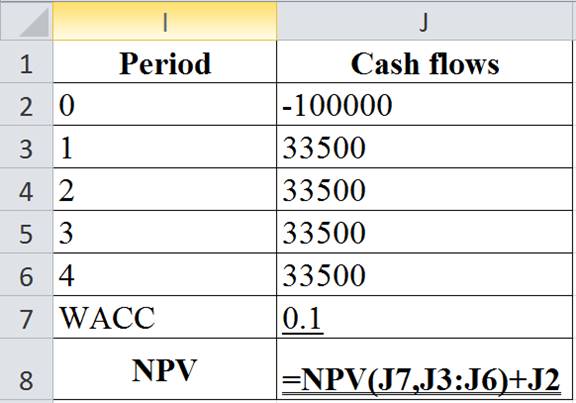
The table below shows the calculated values of NPV for doing the project at present:

Hence, the NPV for doing the project at present is $6,190.49.
Compute the NPV of waiting to do project:
Note: At the time when the project has 50 percent chance of good conditions.
The table below shows the Excel formula to calculate the NPV of waiting to do project:
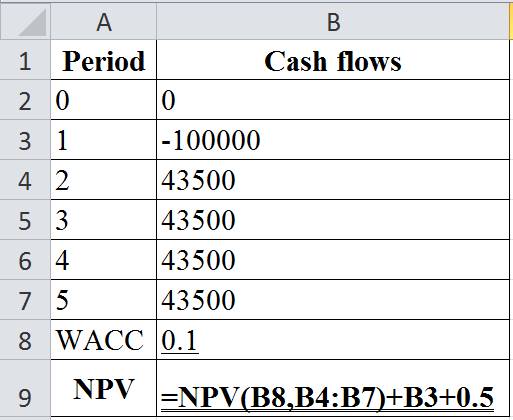
The table below shows the calculated values of NPV of waiting to do project:

Hence, the NPV when the project is in good condition is $37,889.65.
Compute the NPV:
Note: At the time when the project has 50 percent chance of weaker market.
The table below shows the Excel formula to calculate the NPV of waiting to do project:
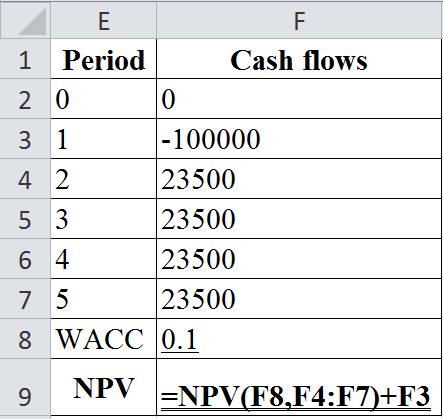
The table below shows the calculated values of NPV of waiting to do project:
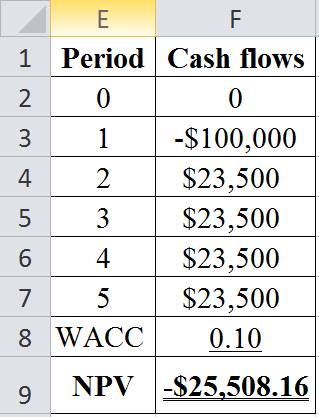
Hence, the NPV when the project is in bad condition is −$25,508.16. Therefore, the company cannot undertake the project in the weaker market because its NPV is less than zero.
Compute the expected NPV of waiting one-year:
Hence, the expected NPV of waiting one-year is $18,944.825. This is the present value for one-year, so it has to be discounted back to determine the current value for waiting to undertake the Project X. As a result, the present value of waiting is $17,222.57
c.
To discuss: Whether the increased uncertainty makes the company more or less willing to invest in the project at present.
Explanation of Solution
Given information:
The C Company’s project has more uncertainty regarding the future cash flows. The annual cash flows are $53,500 when the market is strong and $13,500 when the market is weak. The initial cost is $100,000 and the WACC is 10 percent.
Compute the NPV for strong market condition case:
The table below shows the Excel formula to calculate the NPV:
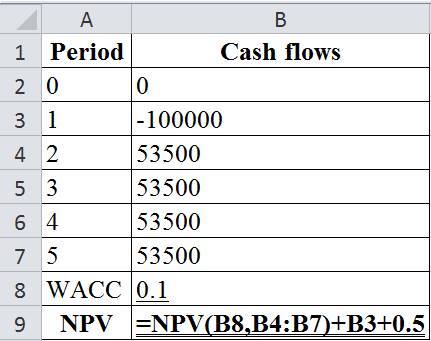
The table below shows the calculated values of NPV:
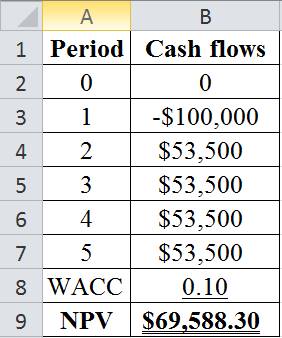
Hence, the NPV when the project is in strong market condition is $69,588.30.
Compute the NPV for weaker market condition case:
The table below shows the Excel formula to calculate the NPV:
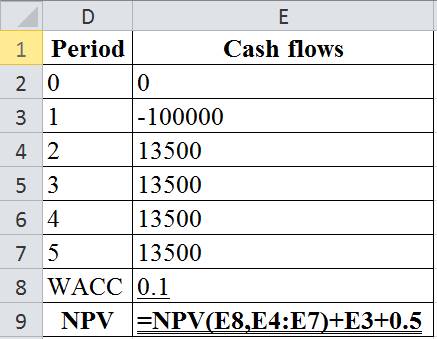
The table below shows the calculated values of NPV:

Hence, the NPV when the project is in bad condition is −$57,206.32. Therefore, the company cannot undertake the project in the weaker market because its NPV is less than zero.
Compute the expected NPV of waiting one-year:
Hence, the expected NPV of waiting one-year is $34,794.15. This is the present value for one-year, so it has to be discounted back to determine the current value for waiting to undertake the Project X. As a result, the present value of waiting is $31,631.05
d.
To discuss: The expected NPV of the project.
1.
NPV is the variation between the present value of the cash outflows and the present value of the cash inflows. In capital budgeting, the NPV is utilized to analyze the profitability of a project or investment.
Explanation of Solution
Given information:
C Company is considering another project that is Project Y. The initial cost of this project is $200,000 and the economic life of the project is 3-years. The after-tax operating cost is $100,000 per year, WACC is 10 percent, and expected after-tax cash inflows are $180,000 a year. The project’s estimated cash flows are as follows:
| Year |
Cash outflows |
Cash inflows |
Estimated project cash flows |
| 0 | -$200,000 | $0 | -$200,000 |
| 1 | -$100,000 | $180,000 | $80,000 |
| 2 | -$100,000 | $180,000 | $80,000 |
| 3 | -$100,000 | $180,000 | $80,000 |
Compute the NPV:
The table below shows the Excel formula to calculate the NPV:
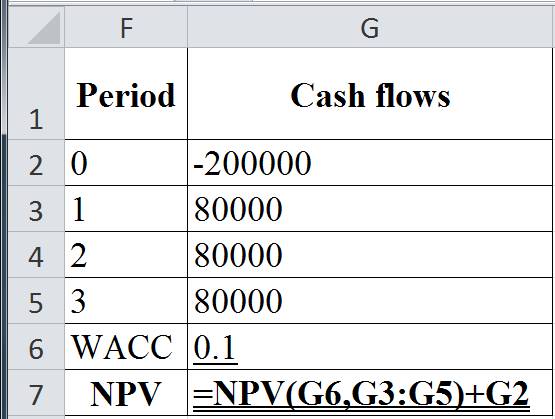
The table below shows the calculated values of NPV:
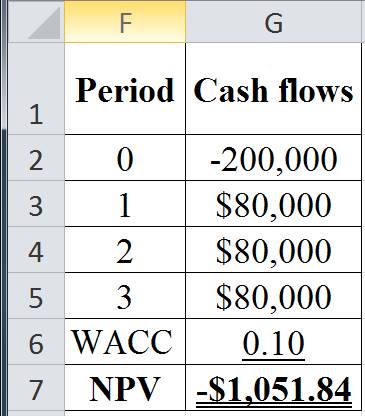
Hence, the expected NPV is −$1,051.84.
2.
To find: The expected NPV of the project in each scenario.
Explanation of Solution
Given information:
The operating cost of the project is $100,000 per year. This project indicates that there is a 60% probability that the customers will use the product and produce after-tax cash inflows of $250,000. The estimated cash flows of the project will be $150,000 per year. Even there is 40% chance that the customer will not use the product and produce after-tax cash inflows of $75,000. In this case, the estimated project’s cash flows is −$25,000.
Compute the NPV when customer uses the product:
The table below shows the Excel formula to calculate the NPV:
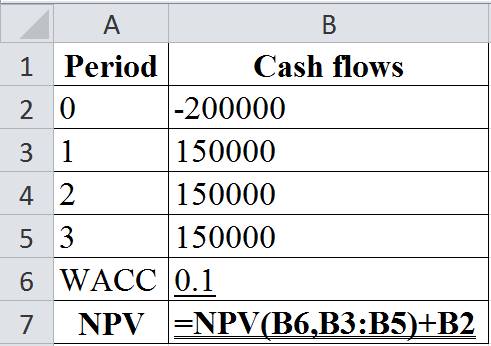
The table below shows the calculated values of NPV when customer uses the product:
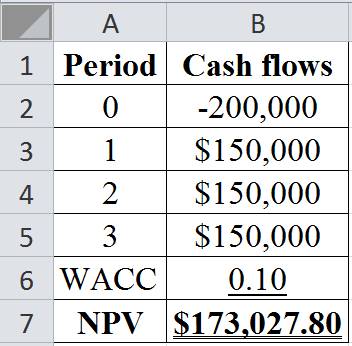
Hence, the NPV when customer uses the product is $173,027.80.
Compute the NPV when customer does not use the product:
The table below shows the Excel formula to calculate the NPV:
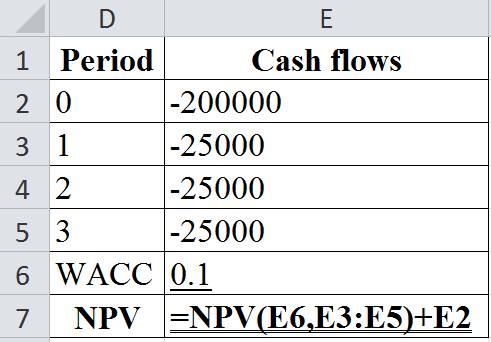
The table below shows the calculated values of NPV when customer does not use the product:
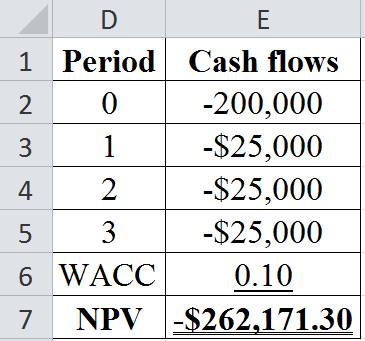
Hence, the NPV when customer does not use the product is −$262,171.30.
Compute the expected NPV:
Hence, the expected NPV is −$1,051.84.
3.
To find: The expected NPV of the project.
Explanation of Solution
Given information:
The operating cost of the project is $100,000 per year. This project indicates that there is a 60% probability that the customers will use the product and produce after-tax cash inflows of $250,000. The estimated cash flows of the project will be $150,000 per year. Even there is 40% chance that the customer will not use the product and produce after-tax cash inflows of $75,000. In this case, the estimated project’s cash flows is −$25,000.
Compute the NPV when there is 60% chance:
The table below shows the Excel formula to calculate the NPV:
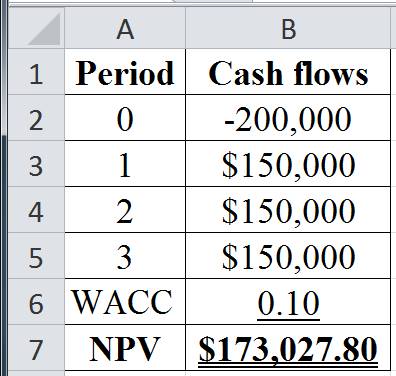
The table below shows the calculated values of NPV when there is 60% chance:

Hence, the NPV when there is 60% chance is $173,027.80.
Compute the NPV when there is 40% chance:
The table below shows the Excel formula to calculate the NPV:
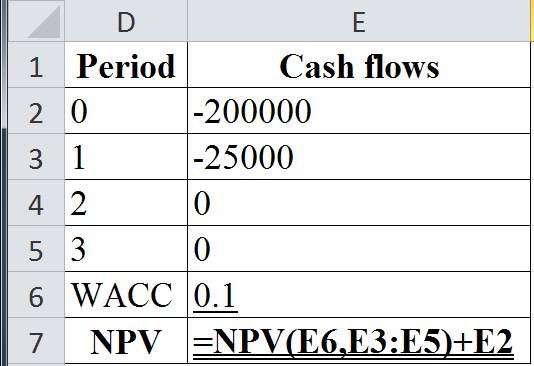
The table below shows the calculated values of NPV when there is 40% chance:
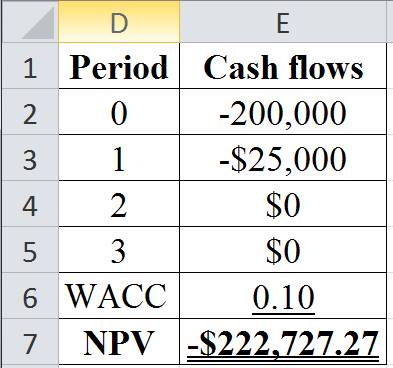
Hence, the NPV when there is 40% chance is −$222,727.27.
Compute the expected NPV:
Hence, the expected NPV is $14,725.772. Therefore, the C Company can execute the project currently.
4.
To discuss: Whether the assumption is reasonable and ways in which the abandonment option affect the WACC.
Explanation of Solution
Determine whether the assumption is reasonable and ways in which the abandonment option affect the WACC:
The assumption is not reasonable to assume that the abandonment option has not effected on the WACC of the project. The abandonment option has the ability to reduce risk and it even reduces the WACC of the project.
e.
To find: Whether the C Company has to invest in Project Z at present.
Explanation of Solution
C Company has decided to invest in Project Z. The initial cost of this project is $500,000 and the expected cash flows produced is $100,000 at the end of next 5-years. The WACC is 12 percent and there is 10 percent chance that the expected NPV of the project will be $3,000,000. Even there is 90 percent chance that the expected NPV will be −$1,000,000.
Compute the NPV when there is 10% chance:
The table below shows the Excel formula to calculate the NPV:
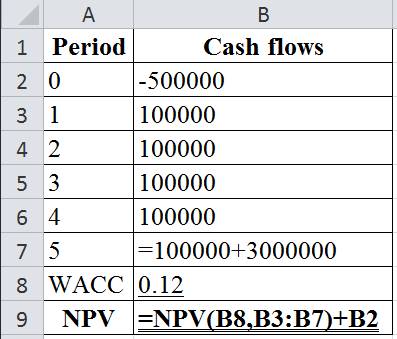
The table below shows the calculated values of NPV when there is 10% chance:

Hence, the NPV when there is 10% chance is $1,562,758.19.
Compute the NPV when there is 90% chance:
The table below shows the Excel formula to calculate the NPV:
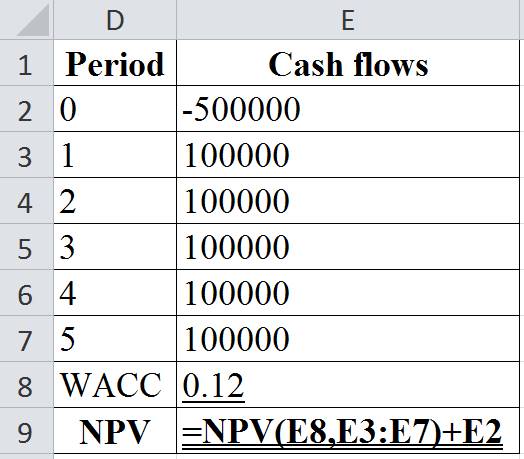
The table below shows the calculated values of NPV when there is 90% chance:
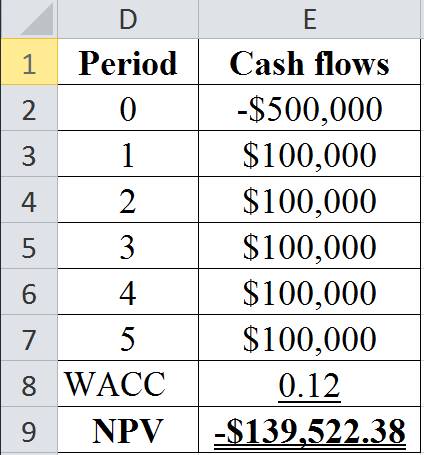
Hence, the NPV when there is 90% chance is −$139,522.38. The C Company will not undertake the project that has a negative NPV of future opportunities. Therefore, the cash flows include only $500,000 and $100,000 inflows.
Compute the expected NPV:
Hence, the expected NPV is $30,705.68. Therefore, the Project Z has a positive NPV so the C Company can invest in the project at present.
Want to see more full solutions like this?
Chapter 13 Solutions
Fundamentals of Financial Management (MindTap Course List)
- The payback period The payback method helps firms establish and identify a maximum acceptable payback period that helps in their capital budgeting decisions. Consider the case of Cold Goose Metal Works Inc.: Cold Goose Metal Works Inc. is a small firm, and several of its managers are worried about how soon the firm will be able to recover its initial investment from Project Delta’s expected future cash flows. To answer this question, Cold Goose’s CFO has asked that you compute the project’s payback period using the following expected net cash flows and assuming that the cash flows are received evenly throughout each year. Complete the following table and compute the project’s conventional payback period. For full credit, complete the entire table. (Note: Round the conventional payback period to two decimal places. If your answer is negative, be sure to use a minus sign in your answer.) Year 0 Year 1 Year 2 Year 3 Expected cash flow -$6,000,000…arrow_forward. The payback period The payback method helps firms establish and identify a maximum acceptable payback period that helps in their capital budgeting decisions. Consider the case of Cold Goose Metal Works Inc.: Cold Goose Metal Works Inc. is a small firm, and several of its managers are worried about how soon the firm will be able to recover its initial investment from Project Delta’s expected future cash flows. To answer this question, Cold Goose’s CFO has asked that you compute the project’s payback period using the following expected net cash flows and assuming that the cash flows are received evenly throughout each year. Complete the following table and compute the project’s conventional payback period. For full credit, complete the entire table. (Note: Round the conventional payback period to two decimal places. If your answer is negative, be sure to use a minus sign in your answer.) Year 0 Year 1 Year 2 Year 3 Expected cash flow -$6,000,000…arrow_forwardSolving for the WACC The WACC is used as the discount rate to evaluate various capital budgeting projects. However, it is important to realize that the WACC is an appropriate discount rate only for a project of average risk. Analyze the cost of capital situations of the following company cases, and answer the specific questions that finance professionals need to address. Consider the case of Turnbull Co. Turnbull Co. has a target capital structure of 58% debt, 6% preferred stock, and 36% common equity. It has a before-tax cost of debt of 11.1%, and its cost of preferred stock is 12.2%. If Turnbull can raise all of its equity capital from retained earnings, its cost of common equity will be 14.7%. However, if it is necessary to raise new common equity, it will carry a cost of 16.8%. Q1. If its current tax rate is 25%, how much higher will Turnbull’s weighted average cost of capital (WACC) be if it has to raise additional common equity capital by issuing new common stock…arrow_forward
- Solving for the WACC The WACC is used as the discount rate to evaluate various capital budgeting projects. However, it is important to realize that the WACC is an appropriate discount rate only for a project of average risk. Analyze the cost of capital situations of the following company cases, and answer the specific questions that finance professionals need to address. Consider the case of Turnbull Co. Turnbull Co. has a target capital structure of 58% debt, 6% preferred stock, and 36% common equity. It has a before-tax cost of debt of 11.1%, and its cost of preferred stock is 12.2%. If Turnbull can raise all of its equity capital from retained earnings, its cost of common equity will be 14.7%. However, if it is necessary to raise new common equity, it will carry a cost of 16.8%. If its current tax rate is 25%, how much higher will Turnbull’s weighted average cost of capital (WACC) be if it has to raise additional common equity capital by issuing new common stock instead…arrow_forwardAll parts are under 1 questions, therefore per your policy all parts can be answered. 6. The payback period The payback method helps firms establish and identify a maximum acceptable payback period that helps in their capital budgeting decisions. Consider the case of Blue Hamster Manufacturing Inc.: Blue Hamster Manufacturing Inc. is a small firm, and several of its managers are worried about how soon the firm will be able to recover its initial investment from Project Delta’s expected future cash flows. To answer this question, Blue Hamster’s CFO has asked that you compute the project’s payback period using the following expected net cash flows and assuming that the cash flows are received evenly throughout each year. A. Complete the following table and compute the project’s conventional payback period. For full credit, complete the entire table. (Note: Round the conventional payback period to two decimal places. If your answer is negative, be sure to use a minus sign in…arrow_forwardrojects differ in risk, and risk analysis is a critical component of the capital budgeting process. Consider the case of United Recycling Inc.: United Recycling Inc. is one of the largest recyclers of glass and paper products in the United States. The company is looking into expanding into the cardboard recycling business. The company’s CFO has performed a detailed analysis of the proposed expansion. The company’s CFO hired a third-party consulting firm to estimate the cost per ton of processing the cardboard. The consulting firm’s cost estimate for processing the cardboard was significantly higher than what the CFO had been using in his financial model. Based on the information given, determine which of the statements is correct. When the CFO adjusts the cost per ton of processing the cardboard, the project’s NPV will decrease. When the CFO adjusts the cost per ton of processing the cardboard, the project’s NPV will increase. Evaluating risk is an…arrow_forward
- The net present value (NPV) and internal rate of return (IRR) methods of investment analysis are interrelated and are sometimes used together to make capital budgeting decisions. Consider the case of Cute Camel Woodcraft Company: Last Tuesday, Cute Camel Woodcraft Company lost a portion of its planning and financial data when both its main and its backup servers crashed. The company’s CFO remembers that the internal rate of return (IRR) of Project Zeta is 14.6%, but he can’t recall how much Cute Camel originally invested in the project nor the project’s net present value (NPV). However, he found a note that detailed the annual net cash flows expected to be generated by Project Zeta. They are: Year Cash Flow Year 1 $2,000,000 Year 2 $3,750,000 Year 3 $3,750,000 Year 4 $3,750,000 The CFO has asked you to compute Project Zeta’s initial investment using the information currently available to you. He has offered the following suggestions and observations: •…arrow_forwardThe net present value (NPV) and internal rate of return (IRR) methods of investment analysis are interrelated and are sometimes used together to make capital budgeting decisions. Consider the case of Cute Camel Woodcraft Company: Last Tuesday, Cute Camel Woodcraft Company lost a portion of its planning and financial data when both its main and its backup servers crashed. The company’s CFO remembers that the internal rate of return (IRR) of Project Lambda is 13.8%, but he can’t recall how much Cute Camel originally invested in the project nor the project’s net present value (NPV). However, he found a note that detailed the annual net cash flows expected to be generated by Project Lambda. They are: Year Cash Flow Year 1 $1,600,000 Year 2 $3,000,000 Year 3 $3,000,000 Year 4 $3,000,000 The CFO has asked you to compute Project Lambda’s initial investment using the information currently available to you. He has offered the following suggestions and observations: • A…arrow_forwardThe net present value (NPV) and internal rate of return (IRR) methods of investment analysis are interrelated and are sometimes used together to make capital budgeting decisions. Consider the case of Green Caterpillar Garden Supplies Inc.: Last Tuesday, Green Caterpillar Garden Supplies Inc. lost a portion of its planning and financial data when both its main and its backup servers crashed. The company’s CFO remembers that the internal rate of return (IRR) of Project Zeta is 14.6%, but he can’t recall how much Green Caterpillar originally invested in the project nor the project’s net present value (NPV). However, he found a note that detailed the annual net cash flows expected to be generated by Project Zeta. They are: Year Cash Flow Year 1 $2,000,000 Year 2 $3,750,000 Year 3 $3,750,000 Year 4 $3,750,000 The CFO has asked you to compute Project Zeta’s initial investment using the information currently available to you. He has offered the following…arrow_forward
- The payback method helps firms establish and identify a maximum acceptable payback period that helps in their capital budgeting decisions. Consider the case of Green Caterpillar Garden Supplies Inc.: Green Caterpillar Garden Supplies Inc. is a small firm, and several of its managers are worried about how soon the firm will be able to recover its initial investment from Project Alpha’s expected future cash flows. To answer this question, Green Caterpillar’s CFO has asked that you compute the project’s payback period using the following expected net cash flows and assuming that the cash flows are received evenly throughout each year. Complete the following table and compute the project’s conventional payback period. For full credit, complete the entire table. (Note: Round the conventional payback period to two decimal places. If your answer is negative, be sure to use a minus sign in your answer.) Year 0 Year 1 Year 2 Year 3 Expected cash flow -$4,500,000…arrow_forwardCapital Budgeting Decisions A college intern working at Anderson Paints evaluated potential investments using the firm’s average required rate of return (r) as the discount rate in the evaluation process and he produced the following report for you as the capital budgeting manager at Anderson Paints: Project NPV IRR Risk LOM $1,500 12.5% High QUE 0 11.0 Low YUP (800) 10.0 Average DOG (150) 9.5 Low As the capital investment manager you must account for the risks associated with capital budgeting projects before making final recommendations and decisions. The company’s capital investment risk management policy calls for an adjustment of the firm’s average required rate of return by plus/minus 2% if a project’s…arrow_forward1. Why does WACC increase and IRR decrease as the capital budget increases? Are there any steps management can take to reverse these trends? 2. How should a company prioritize all of its capital project opportunities? In responding invoke the various methodologies learned this week and how to use them for ranking projects.arrow_forward
 Fundamentals of Financial Management, Concise Edi...FinanceISBN:9781285065137Author:Eugene F. Brigham, Joel F. HoustonPublisher:Cengage Learning
Fundamentals of Financial Management, Concise Edi...FinanceISBN:9781285065137Author:Eugene F. Brigham, Joel F. HoustonPublisher:Cengage Learning
